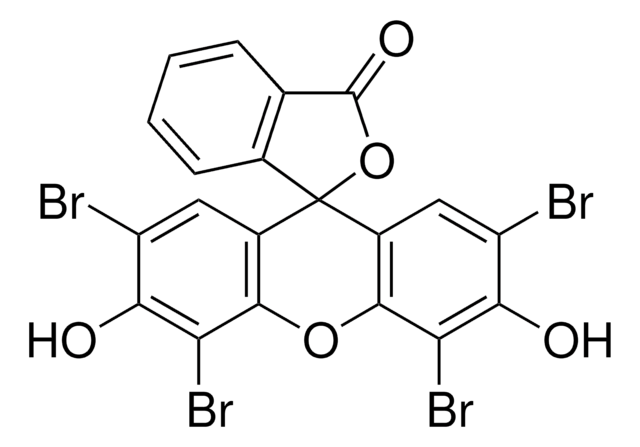33420
1-Naphthol
puriss. p.a., reag. Ph. Eur., ≥99% (GC)
Synonim(y):
α-Naphthol, 1-Hydroxynaphthalene
About This Item
Polecane produkty
agency
USP/NF
reag. Ph. Eur.
Poziom jakości
gęstość pary
4.5 (120 °C, vs air)
ciśnienie pary
1 mmHg ( 94 °C)
klasa czystości
puriss. p.a.
Próba
≥99% (GC)
temp. samozapłonu
1007 °F
granice wybuchowości
5 %
zanieczyszczenia
≤0.001% heavy metals (as Pb)
≤0.2% naphthaline (GC)
≤0.2% water (Karl Fischer)
≤0.5% 2-naphthol (GC)
pozostałość po prażeniu
≤0.05% (as SO4)
tw
278-280 °C (lit.)
mp
94-96 °C (lit.)
94-97 °C
ślady anionów
chloride (Cl-): ≤50 mg/kg
ślady kationów
Fe: ≤10 mg/kg
ciąg SMILES
Oc1cccc2ccccc12
InChI
1S/C10H8O/c11-10-7-3-5-8-4-1-2-6-9(8)10/h1-7,11H
Klucz InChI
KJCVRFUGPWSIIH-UHFFFAOYSA-N
informacje o genach
human ... CYP1A2(1544)
Szukasz podobnych produktów? Odwiedź Przewodnik dotyczący porównywania produktów
Zastosowanie
- A ′conovenomic′ analysis of the milked venom from the mollusk-hunting cone snail Conus textile--the pharmacological importance of post-translational modifications.: This research underscores the critical role of post-translational modifications in the biological activity of peptides derived from cone snail venom, illustrating the potential for developing novel pharmacological agents using peptide synthesis techniques like those involving Fmoc-Asp(OtBu)-OH (Bergeron et al., 2013).
- Parallel high-throughput accurate mass measurement using a nine-channel multiplexed electrospray liquid chromatography ultraviolet time-of-flight mass spectrometry system.: This paper discusses a breakthrough in mass spectrometry, highlighting a method for high-throughput analysis which could be critical for the characterization of complex peptide products synthesized using Fmoc-Asp(OtBu)-OH (Fang et al., 2003).
Opakowanie
Hasło ostrzegawcze
Danger
Zwroty wskazujące rodzaj zagrożenia
Zwroty wskazujące środki ostrożności
Klasyfikacja zagrożeń
Acute Tox. 3 Dermal - Acute Tox. 4 Oral - Aquatic Acute 1 - Aquatic Chronic 3 - Eye Dam. 1 - Skin Irrit. 2 - Skin Sens. 1A - STOT SE 2 Oral - STOT SE 3
Organy docelowe
Kidney, Respiratory system
Kod klasy składowania
6.1C - Combustible acute toxic Cat.3 / toxic compounds or compounds which causing chronic effects
Klasa zagrożenia wodnego (WGK)
WGK 1
Temperatura zapłonu (°F)
257.0 °F - closed cup
Temperatura zapłonu (°C)
125 °C - closed cup
Środki ochrony indywidualnej
dust mask type N95 (US), Eyeshields, Faceshields, Gloves, type P3 (EN 143) respirator cartridges
Choose from one of the most recent versions:
Masz już ten produkt?
Dokumenty związane z niedawno zakupionymi produktami zostały zamieszczone w Bibliotece dokumentów.
Klienci oglądali również te produkty
Nasz zespół naukowców ma doświadczenie we wszystkich obszarach badań, w tym w naukach przyrodniczych, materiałoznawstwie, syntezie chemicznej, chromatografii, analityce i wielu innych dziedzinach.
Skontaktuj się z zespołem ds. pomocy technicznej











